This is a fixed-text formatted version of a Jupyter notebook
You can contribute with your own notebooks in this GitHub repository.
Source files: analysis_3d.ipynb | analysis_3d.py
3D analysis¶
This tutorial does a 3D map based analsis on the galactic center, using simulated observations from the CTA-1DC. We will use the high level interface for the data reduction, and then do a detailed modelling. This will be done in two different ways:
stacking all the maps together and fitting the stacked maps
handling all the observations separately and doing a joint fitting on all the maps
[1]:
%matplotlib inline
import matplotlib.pyplot as plt
import astropy.units as u
from pathlib import Path
from regions import CircleSkyRegion
from gammapy.analysis import Analysis, AnalysisConfig
from gammapy.modeling.models import (
SkyModel,
ExpCutoffPowerLawSpectralModel,
PointSpatialModel,
)
from gammapy.modeling import Fit
from gammapy.maps import Map
Analysis configuration¶
In this section we select observations and define the analysis geometries, irrespective of joint/stacked analysis. For configuration of the analysis, we will programatically build a config file from scratch.
[2]:
config = AnalysisConfig()
# The config file is now empty, with only a few defaults specified.
print(config)
AnalysisConfig
general:
log: {level: info, filename: null, filemode: null, format: null, datefmt: null}
outdir: .
observations:
datastore: $GAMMAPY_DATA/hess-dl3-dr1
obs_ids: []
obs_file: null
obs_cone: {frame: null, lon: null, lat: null, radius: null}
obs_time: {start: null, stop: null}
datasets:
type: 1d
stack: true
geom:
wcs:
skydir: {frame: null, lon: null, lat: null}
binsize: 0.02 deg
fov: {width: 5.0 deg, height: 5.0 deg}
binsize_irf: 0.2 deg
selection: {offset_max: 2.5 deg}
axes:
energy: {min: 0.1 TeV, max: 10.0 TeV, nbins: 30}
energy_true: {min: 0.1 TeV, max: 10.0 TeV, nbins: 30}
map_selection: [counts, exposure, background, psf, edisp]
background:
method: null
exclusion: null
parameters: {}
safe_mask:
methods: [aeff-default]
parameters: {}
on_region: {frame: null, lon: null, lat: null, radius: null}
containment_correction: true
fit:
fit_range: {min: 0.1 TeV, max: 10.0 TeV}
flux_points:
energy: {min: 0.1 TeV, max: 10.0 TeV, nbins: 30}
source: source
parameters: {}
[3]:
# Selecting the observations
config.observations.datastore = "$GAMMAPY_DATA/cta-1dc/index/gps/"
config.observations.obs_ids = [110380, 111140, 111159]
[4]:
# Defining a reference geometry for the reduced datasets
config.datasets.type = "3d" # Analysis type is 3D
config.datasets.geom.wcs.skydir = {
"lon": "0 deg",
"lat": "0 deg",
"frame": "galactic",
} # The WCS geometry - centered on the galactic center
config.datasets.geom.wcs.fov = {"width": "10 deg", "height": "8 deg"}
config.datasets.geom.wcs.binsize = "0.02 deg"
# The FoV radius to use for cutouts
config.datasets.geom.selection.offset_max = 3.5 * u.deg
config.datasets.safe_mask.methods = ["aeff-default", "offset-max"]
# We now fix the energy axis for the counts map - (the reconstructed energy binning)
config.datasets.geom.axes.energy.min = "0.1 TeV"
config.datasets.geom.axes.energy.max = "10 TeV"
config.datasets.geom.axes.energy.nbins = 10
# We now fix the energy axis for the IRF maps (exposure, etc) - (the true enery binning)
config.datasets.geom.axes.energy_true.min = "0.08 TeV"
config.datasets.geom.axes.energy_true.max = "12 TeV"
config.datasets.geom.axes.energy_true.nbins = 14
[5]:
print(config)
AnalysisConfig
general:
log: {level: info, filename: null, filemode: null, format: null, datefmt: null}
outdir: .
observations:
datastore: $GAMMAPY_DATA/cta-1dc/index/gps
obs_ids: [110380, 111140, 111159]
obs_file: null
obs_cone: {frame: null, lon: null, lat: null, radius: null}
obs_time: {start: null, stop: null}
datasets:
type: 3d
stack: true
geom:
wcs:
skydir: {frame: galactic, lon: 0.0 deg, lat: 0.0 deg}
binsize: 0.02 deg
fov: {width: 10.0 deg, height: 8.0 deg}
binsize_irf: 0.2 deg
selection: {offset_max: 3.5 deg}
axes:
energy: {min: 0.1 TeV, max: 10.0 TeV, nbins: 10}
energy_true: {min: 0.08 TeV, max: 12.0 TeV, nbins: 14}
map_selection: [counts, exposure, background, psf, edisp]
background:
method: null
exclusion: null
parameters: {}
safe_mask:
methods: [aeff-default, offset-max]
parameters: {}
on_region: {frame: null, lon: null, lat: null, radius: null}
containment_correction: true
fit:
fit_range: {min: 0.1 TeV, max: 10.0 TeV}
flux_points:
energy: {min: 0.1 TeV, max: 10.0 TeV, nbins: 30}
source: source
parameters: {}
Configuration for stacked and joint analysis¶
This is done just by specfiying the flag on config.datasets.stack. Since the internal machinery will work differently for the two cases, we will write it as two config files and save it to disc in YAML format for future reference.
[6]:
config_stack = config.copy(deep=True)
config_stack.datasets.stack = True
config_joint = config.copy(deep=True)
config_joint.datasets.stack = False
[7]:
# To prevent unnecessary cluttering, we write it in a separate folder.
path = Path("analysis_3d")
path.mkdir(exist_ok=True)
config_joint.write(path=path / "config_joint.yaml", overwrite=True)
config_stack.write(path=path / "config_stack.yaml", overwrite=True)
Stacked analysis¶
Data reduction¶
We first show the steps for the stacked analysis and then repeat the same for the joint analysis later
[8]:
# Reading yaml file:
config_stacked = AnalysisConfig.read(path=path / "config_stack.yaml")
[9]:
analysis_stacked = Analysis(config_stacked)
Setting logging config: {'level': 'INFO', 'filename': None, 'filemode': None, 'format': None, 'datefmt': None}
[10]:
%%time
# select observations:
analysis_stacked.get_observations()
# run data reduction
analysis_stacked.get_datasets()
Fetching observations.
Number of selected observations: 3
Creating geometry.
Creating datasets.
No background maker set for 3d analysis. Check configuration.
Processing observation 110380
No thresholds defined for obs Observation
obs id : 110380
tstart : 59235.50
tstop : 59235.52
duration : 1800.00 s
pointing (icrs) : 267.7 deg, -29.6 deg
deadtime fraction : 2.0%
Processing observation 111140
No thresholds defined for obs Observation
obs id : 111140
tstart : 59275.50
tstop : 59275.52
duration : 1800.00 s
pointing (icrs) : 264.2 deg, -29.5 deg
deadtime fraction : 2.0%
Processing observation 111159
No thresholds defined for obs Observation
obs id : 111159
tstart : 59276.50
tstop : 59276.52
duration : 1800.00 s
pointing (icrs) : 266.0 deg, -27.0 deg
deadtime fraction : 2.0%
CPU times: user 7.66 s, sys: 2.27 s, total: 9.93 s
Wall time: 10.3 s
We have one final dataset, which you can print and explore
[11]:
dataset_stacked = analysis_stacked.datasets["stacked"]
print(dataset_stacked)
MapDataset
----------
Name : stacked
Total counts : 121241
Total predicted counts : 108043.52
Total background counts : 108043.52
Exposure min : 6.28e+07 m2 s
Exposure max : 1.90e+10 m2 s
Number of total bins : 2000000
Number of fit bins : 1411180
Fit statistic type : cash
Fit statistic value (-2 log(L)) : 625436.39
Number of models : 1
Number of parameters : 3
Number of free parameters : 1
Component 0: BackgroundModel
Name : stacked-bkg
Datasets names : ['stacked']
Parameters:
norm : 1.000
tilt (frozen) : 0.000
reference (frozen) : 1.000 TeV
[12]:
# To plot a smooth counts map
dataset_stacked.counts.smooth(0.02 * u.deg).plot_interactive(add_cbar=True)
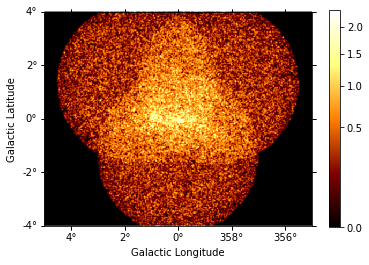
[13]:
# And the background map
dataset_stacked.background_model.map.plot_interactive(add_cbar=True)

[14]:
# You can also get an excess image with a few lines of code:
counts = dataset_stacked.counts.sum_over_axes()
background = dataset_stacked.background_model.map.sum_over_axes()
excess = counts - background
excess.smooth("0.06 deg").plot(stretch="sqrt", add_cbar=True);
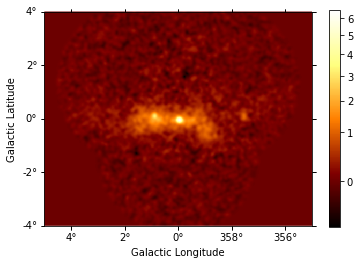
Modeling and fitting¶
Now comes the interesting part of the analysis - choosing appropriate models for our source and fitting them.
We choose a point source model with an exponential cutoff power-law spectrum.
To select a certain energy range for the fit we can create a fit mask:
[15]:
coords = dataset_stacked.counts.geom.get_coord()
mask_energy = coords["energy"] > 0.3 * u.TeV
dataset_stacked.mask_fit = Map.from_geom(
geom=dataset_stacked.counts.geom, data=mask_energy
)
[16]:
spatial_model = PointSpatialModel(
lon_0="-0.05 deg", lat_0="-0.05 deg", frame="galactic"
)
spectral_model = ExpCutoffPowerLawSpectralModel(
index=2.3,
amplitude=2.8e-12 * u.Unit("cm-2 s-1 TeV-1"),
reference=1.0 * u.TeV,
lambda_=0.02 / u.TeV,
)
model = SkyModel(
spatial_model=spatial_model,
spectral_model=spectral_model,
name="gc-source",
)
dataset_stacked.models.append(model)
dataset_stacked.background_model.norm.value = 1.3
[17]:
%%time
fit = Fit([dataset_stacked])
result = fit.run(optimize_opts={"print_level": 1})
------------------------------------------------------------------
| FCN = 2.802E+05 | Ncalls=177 (177 total) |
| EDM = 9.39E-05 (Goal: 1E-05) | up = 1.0 |
------------------------------------------------------------------
| Valid Min. | Valid Param. | Above EDM | Reached call limit |
------------------------------------------------------------------
| True | True | False | False |
------------------------------------------------------------------
| Hesse failed | Has cov. | Accurate | Pos. def. | Forced |
------------------------------------------------------------------
| False | True | True | True | False |
------------------------------------------------------------------
CPU times: user 9.19 s, sys: 2.41 s, total: 11.6 s
Wall time: 11.7 s
[18]:
result.parameters.to_table()
[18]:
| name | value | unit | min | max | frozen | error |
|---|---|---|---|---|---|---|
| str9 | float64 | str14 | float64 | float64 | bool | float64 |
| norm | 1.248e+00 | 0.000e+00 | nan | False | 6.448e-03 | |
| tilt | 0.000e+00 | nan | nan | True | 0.000e+00 | |
| reference | 1.000e+00 | TeV | nan | nan | True | 0.000e+00 |
| index | 2.240e+00 | nan | nan | False | 1.146e-01 | |
| amplitude | 2.909e-12 | cm-2 s-1 TeV-1 | nan | nan | False | 3.341e-13 |
| reference | 1.000e+00 | TeV | nan | nan | True | 0.000e+00 |
| lambda_ | 5.311e-02 | TeV-1 | nan | nan | False | 6.112e-02 |
| alpha | 1.000e+00 | nan | nan | True | 0.000e+00 | |
| lon_0 | -5.166e-02 | deg | nan | nan | False | 2.338e-03 |
| lat_0 | -5.244e-02 | deg | -9.000e+01 | 9.000e+01 | False | 2.244e-03 |
Check model fit¶
We check the model fit by computing and plotting a residual image:
[19]:
dataset_stacked.plot_residuals(method="diff/sqrt(model)", vmin=-1, vmax=1)
[19]:
(<matplotlib.axes._subplots.WCSAxesSubplot at 0x116012c18>, None)
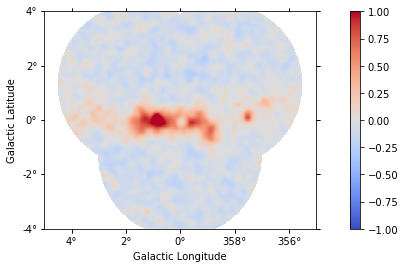
We can also plot the best fit spectrum. For that need to extract the covariance of the spectral parameters.
Joint analysis¶
In this section, we perform a joint analysis of the same data. Of course, joint fitting is considerably heavier than stacked one, and should always be handled with care. For brevity, we only show the analysis for a point source fitting without re-adding a diffuse component again.
Data reduction¶
[20]:
%%time
# Read the yaml file from disk
config_joint = AnalysisConfig.read(path=path / "config_joint.yaml")
analysis_joint = Analysis(config_joint)
# select observations:
analysis_joint.get_observations()
# run data reduction
analysis_joint.get_datasets()
Setting logging config: {'level': 'INFO', 'filename': None, 'filemode': None, 'format': None, 'datefmt': None}
Fetching observations.
Number of selected observations: 3
Creating geometry.
Creating datasets.
No background maker set for 3d analysis. Check configuration.
Processing observation 110380
No thresholds defined for obs Observation
obs id : 110380
tstart : 59235.50
tstop : 59235.52
duration : 1800.00 s
pointing (icrs) : 267.7 deg, -29.6 deg
deadtime fraction : 2.0%
Processing observation 111140
No thresholds defined for obs Observation
obs id : 111140
tstart : 59275.50
tstop : 59275.52
duration : 1800.00 s
pointing (icrs) : 264.2 deg, -29.5 deg
deadtime fraction : 2.0%
Processing observation 111159
No thresholds defined for obs Observation
obs id : 111159
tstart : 59276.50
tstop : 59276.52
duration : 1800.00 s
pointing (icrs) : 266.0 deg, -27.0 deg
deadtime fraction : 2.0%
CPU times: user 6.94 s, sys: 1.97 s, total: 8.91 s
Wall time: 9.01 s
[21]:
# You can see there are 3 datasets now
print(analysis_joint.datasets)
Datasets
--------
idx=0, id='0x1180b8c18', name='-fbzIRNK'
idx=1, id='0x115ccf550', name='tk5xvVAM'
idx=2, id='0x115fc0080', name='1cpoqF7u'
[22]:
# You can access each one by name or by index, eg:
print(analysis_joint.datasets[0])
MapDataset
----------
Name : -fbzIRNK
Total counts : 47736
Total predicted counts : 42655.01
Total background counts : 42655.01
Exposure min : 6.28e+07 m2 s
Exposure max : 6.68e+09 m2 s
Number of total bins : 1085000
Number of fit bins : 693940
Fit statistic type : cash
Fit statistic value (-2 log(L)) : 250423.04
Number of models : 1
Number of parameters : 3
Number of free parameters : 1
Component 0: BackgroundModel
Name : -fbzIRNK-bkg
Datasets names : ['-fbzIRNK']
Parameters:
norm : 1.000
tilt (frozen) : 0.000
reference (frozen) : 1.000 TeV
[23]:
# Add the model on each of the datasets
model_joint = model.copy(name="source-joint")
for dataset in analysis_joint.datasets:
dataset.models.append(model_joint)
dataset.background_model.norm.value = 1.1
[24]:
%%time
fit_joint = Fit(analysis_joint.datasets)
result_joint = fit_joint.run()
CPU times: user 27 s, sys: 5.37 s, total: 32.4 s
Wall time: 32.7 s
[25]:
print(result)
OptimizeResult
backend : minuit
method : minuit
success : True
message : Optimization terminated successfully.
nfev : 177
total stat : 280219.84
[26]:
fit_joint.datasets.parameters.to_table()
[26]:
| name | value | unit | min | max | frozen | error |
|---|---|---|---|---|---|---|
| str9 | float64 | str14 | float64 | float64 | bool | float64 |
| norm | 1.117e+00 | 0.000e+00 | nan | False | 5.577e-03 | |
| tilt | 0.000e+00 | nan | nan | True | 0.000e+00 | |
| reference | 1.000e+00 | TeV | nan | nan | True | 0.000e+00 |
| index | 2.290e+00 | nan | nan | False | 7.647e-02 | |
| amplitude | 2.885e-12 | cm-2 s-1 TeV-1 | nan | nan | False | 3.116e-13 |
| reference | 1.000e+00 | TeV | nan | nan | True | 0.000e+00 |
| lambda_ | 3.500e-02 | TeV-1 | nan | nan | False | 5.131e-02 |
| alpha | 1.000e+00 | nan | nan | True | 0.000e+00 | |
| lon_0 | -5.244e-02 | deg | nan | nan | False | 2.225e-03 |
| lat_0 | -5.247e-02 | deg | -9.000e+01 | 9.000e+01 | False | 2.144e-03 |
| norm | 1.119e+00 | 0.000e+00 | nan | False | 5.580e-03 | |
| tilt | 0.000e+00 | nan | nan | True | 0.000e+00 | |
| reference | 1.000e+00 | TeV | nan | nan | True | 0.000e+00 |
| norm | 1.111e+00 | 0.000e+00 | nan | False | 5.561e-03 | |
| tilt | 0.000e+00 | nan | nan | True | 0.000e+00 | |
| reference | 1.000e+00 | TeV | nan | nan | True | 0.000e+00 |
The information which parameter belongs to which dataset is not listed explicitly in the table (yet), but the order of parameters is conserved. You can always access the underlying object tree as well to get specific parameter values:
[27]:
for dataset in analysis_joint.datasets:
print(dataset.background_model.norm.value)
1.1172921144380115
1.1185249877971581
1.1111161210830067
Residuals¶
Since we have multiple datasets, we can either look at a stacked residual map, or the residuals for each dataset. Each gammapy.cube.MapDataset object is equipped with a method called gammapy.cube.MapDataset.plot_residuals(), which displays the spatial and spectral residuals (computed as counts-model) for the dataset. Optionally, these can be normalized as (counts-model)/model or (counts-model)/sqrt(model), by passing the parameter norm='model or norm=sqrt_model.
[28]:
# To see the spectral residuals, we have to define a region for the spectral extraction
region = CircleSkyRegion(spatial_model.position, radius=0.15 * u.deg)
[29]:
for dataset in analysis_joint.datasets:
ax_image, ax_spec = dataset.plot_residuals(
region=region, vmin=-0.5, vmax=0.5, method="diff"
)

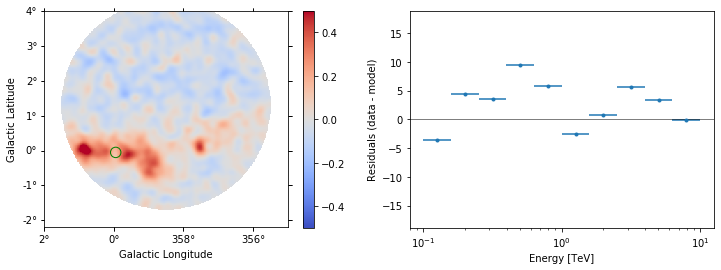
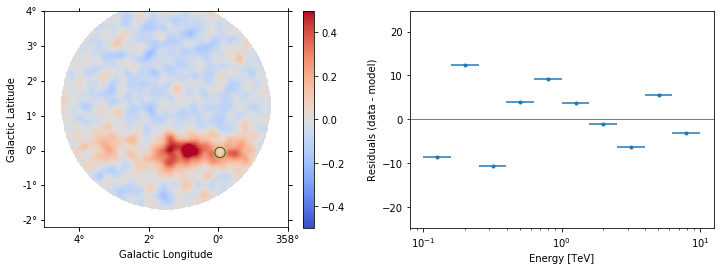
[30]:
# We need to stack on the full geometry, so we use to geom from the stacked counts map.
residuals_stacked = Map.from_geom(analysis_stacked.datasets[0].counts.geom)
for dataset in analysis_joint.datasets:
residuals = dataset.residuals()
residuals_stacked.stack(residuals)
residuals_stacked.sum_over_axes().smooth("0.08 deg").plot(
vmin=-1, vmax=1, cmap="coolwarm", add_cbar=True, stretch="linear"
);

Finally let us compare the spectral results from the stacked and joint fit:
[31]:
def plot_spectrum(model, result, label, color):
spec = model.spectral_model
energy_range = [0.3, 10] * u.TeV
spec.plot(
energy_range=energy_range, energy_power=2, label=label, color=color
)
spec.plot_error(energy_range=energy_range, energy_power=2, color=color)
[32]:
plot_spectrum(model, result, label="stacked", color="tab:blue")
plot_spectrum(model_joint, result_joint, label="joint", color="tab:orange")
plt.legend()
[32]:
<matplotlib.legend.Legend at 0x115c96278>
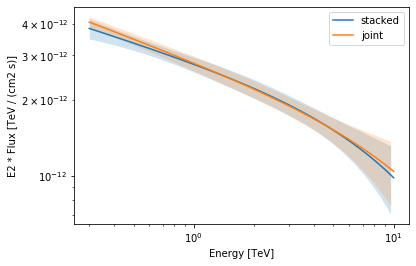
Summary¶
Note that this notebook aims to show you the procedure of a 3D analysis using just a few observations. Results get much better for a more complete analysis considering the GPS dataset from the CTA First Data Challenge (DC-1) and also the CTA model for the Galactic diffuse emission, as shown in the next image:
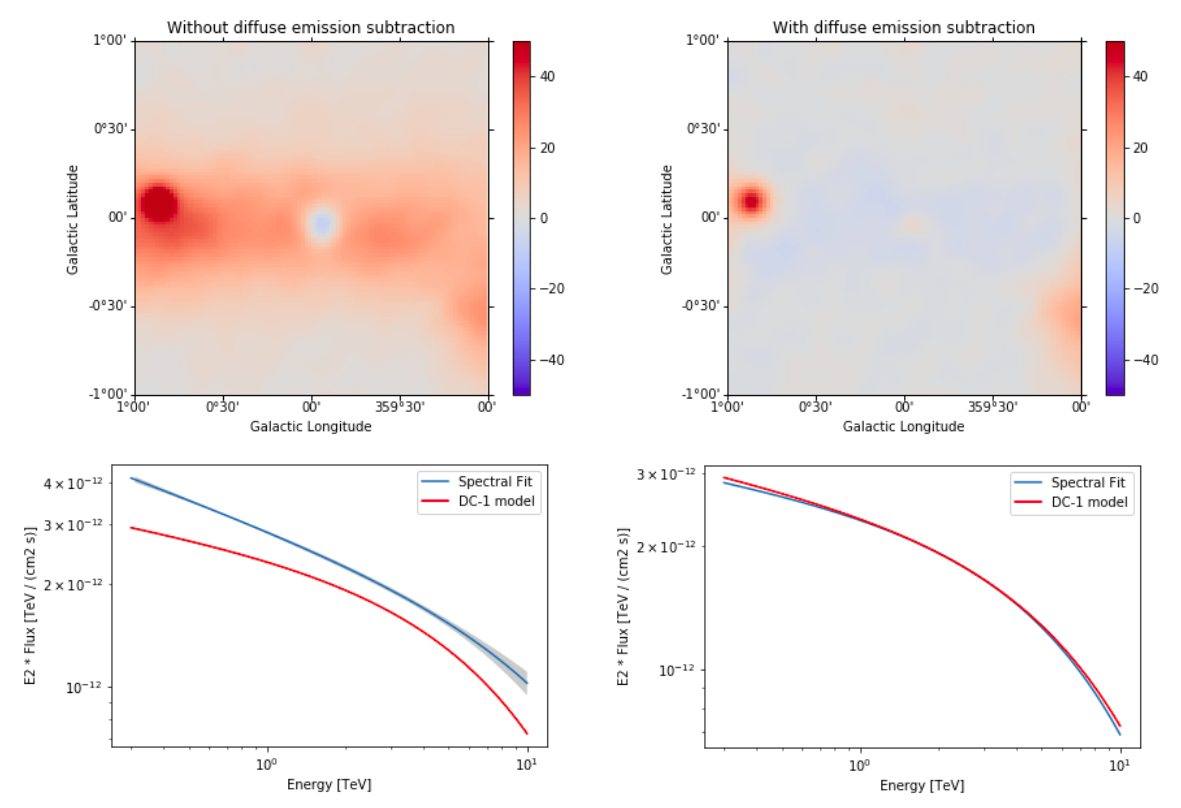
The complete tutorial notebook of this analysis is available to be downloaded in GAMMAPY-EXTRA repository at https://github.com/gammapy/gammapy-extra/blob/master/analyses/cta_1dc_gc_3d.ipynb).
Exercises¶
Analyse the second source in the field of view: G0.9+0.1 and add it to the combined model.
Perform modeling in more details - Add diffuse component, get flux points.
